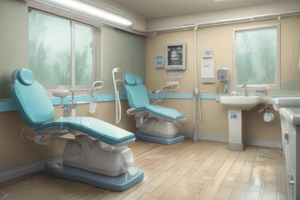Podcast
Questions and Answers
What type of microorganisms are mentioned as disease-causing?
What type of microorganisms are mentioned as disease-causing?
- Parasites, prions, allergens
- Bacteria, viruses, fungi (correct)
- Fungi, toxins, parasites
- Bacteria, viruses, toxins
Which of the following is a mode of transmission in a dental setting?
Which of the following is a mode of transmission in a dental setting?
- Indirect contact with clean surfaces
- Direct contact with blood and oral fluids (correct)
- Indirect contact with healthy individuals
- Direct contact with personal items
What body fluids are considered potential sources of infection in a clinical setting?
What body fluids are considered potential sources of infection in a clinical setting?
- Blood, oral fluids, secretions, and excretions (correct)
- Sweat and saliva
- Only saliva
- Urine and tears
How might a seemingly healthy person pose an infection risk?
How might a seemingly healthy person pose an infection risk?
What is an example of indirect contact in a dental setting?
What is an example of indirect contact in a dental setting?
What can become contaminated later according to the information provided?
What can become contaminated later according to the information provided?
Which of the following can lead to contamination of instruments and devices?
Which of the following can lead to contamination of instruments and devices?
Which of the following is NOT a possible outcome of contaminated surfaces?
Which of the following is NOT a possible outcome of contaminated surfaces?
What is a significant concern resulting from contaminated surfaces?
What is a significant concern resulting from contaminated surfaces?
What type of items can be affected by contamination from surfaces?
What type of items can be affected by contamination from surfaces?
Flashcards are hidden until you start studying
Study Notes
Disease-Causing Microorganisms
- Key types include bacteria, viruses, and fungi that can lead to infections.
- Healthy-appearing individuals may unknowingly carry serious infections, serving as carriers.
Mode of Transmission in Dental Settings
-
Clinical Contact
- Direct contact with blood, saliva, or other patient materials poses a risk.
- Body fluids, including blood and oral secretions, are common reservoirs for pathogens.
-
Surfaces
- Indirect contact occurs through contaminated objects like instruments or devices.
- Contaminated surfaces can transmit infections via handling or contact with hands and gloves.
Infection Pathways
- Contamination can spread from surfaces to:
- Healthcare providers' hands or gloves, then to other patients.
- Partners sexually, indicating a communicable nature.
- Vertical transmission from mother to fetus, introducing risks during pregnancy.
Sterilization Monitoring
- Essential to use mechanical, chemical, and biological monitors to confirm sterilization effectiveness.
- The efficacy of sterilization is influenced by the concentration of microorganisms and disinfectants, as well as the contact time.
Studying That Suits You
Use AI to generate personalized quizzes and flashcards to suit your learning preferences.




